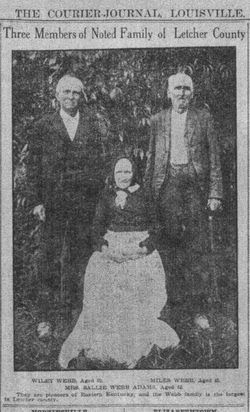
|
| If you resemble any of these people, you probably live in Kentucky. |
At the far eastern edge of Kentucky, nestled in Appalachia, resides Letcher County. In spite of its isolation and poverty (approximately 30% of the county's population lives below the poverty line), Letcher County has managed to grow at an impressive rate, from a population of just 9,172 in 1900 to a present-day population of nearly 25,000. However, even if Letcher County tripled or quadrupled its present population, there's still a pretty good chance that virtually all of the county's inhabitants would be related to each other-- thanks to one particularly fertile family whose astounding rate of reproduction can put even the friskiest rabbit to shame.
Around the year 1900, Letcher County was the home of a man by the name of Jason L. Webb, who made national headlines for having the one of the largest families in the world. According to newspaper reports of the era, Jason had 19 children, 175 grandchildren, and 100 great-grandchildren. Perhaps even more impressive was his brother, Miles Webb, who had more than 400 direct descendants, of which 255 were grandchildren or great-grandchildren. Other siblings were equally as fond of "doing the horizontal polka" as Jason and Miles. Their brother Enoch had ten children, another brother named Wiley had seven, and sister Sallie had five. Another sister, Mary, only had two children. Apparently she was the prudish one of the family.
At any rate, the Webb's proclivity for procreation was single-handedly responsible for Letcher County's population growth spurt in the early 20th century; between 1890 and 1900, the county experienced an impressive 32.5% increase in population, with 9,172 people calling Letcher County home. However, by this time, the Webb clan alone numbered around 12,000. In other words, virtually 100% of the county had a Webb somewhere in the family tree.
Of course, not every descendant of Jason, Miles and Enoch remained in Letcher County. Many Webbs can still be found in neighboring Harlan, Perry, and Pike Counties. But because of the fact that most of Letcher County's railroads and highways weren't built until the 1920s and 30s, the vast majority of Webbs remained close to home. As a result, it's safe to assume that rural Letcher County in Kentucky is the unofficial inbreeding and incest capital of America, if not the entire world.
To put it in perspective, the Webb surname is proportionally more popular in Kentucky than in just about any other state. Findagrave.com lists graves for 4,030 Webbs in the state of Kentucky. Kentucky has a total population of 4,413,457 (26th in rank). By comparison, Colorado, which has a population of 5,355,866 (22nd in rank) only has 608 Webbs buried there, according to Findagrave.com. Only 434 Webbs are buried in Minnesota, which has an even larger total population with 5,457,173. Jason and Miles Webb, the two most notorious procreators of the clan, are buried in the tiny village of Mayking in Letcher County, where they rest in the same cemetery along with 132 other Webbs.